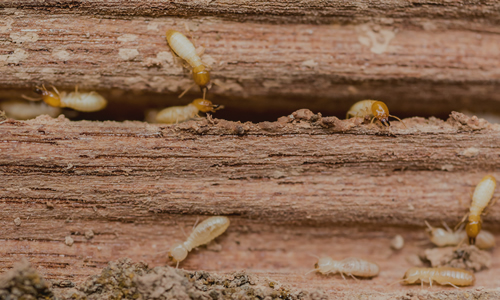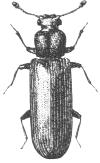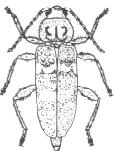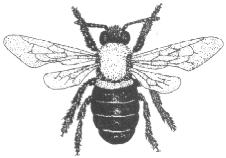


Carpenter Ants
Carpenter ants have one node and come in many varieties with different sizes and colors — tan, black, and red.
HABITS: Carpenter ants hollow out dead, moist wood in trees, firewood, and fence posts to build nests but they don’t eat wood. Inside, they build colonies in wall voids, foam insulation, eaves, crawl spaces behind siding, in attic insulation and many other places, usually in areas where leakage has caused moisture to accumulate . They forage at night during summer, however they often invade structures in spring and fall looking for food sources. Many times homeowners will find these ants swarming inside, especially around lights and windows.
DIET: Found throughout the U.S., they feed on insects and insect secretions but also likes sweets and other foods.
Detecting Infestation: First you will want to locate the colony. This may be done by inspecting areas of structures associated with high moisture, or check areas like windows and door frames, sills, tub enclosure walls, and around kitchen and bath plumbing walls. Also check trees and tree stumps close to structures and where limbs touch structure. You can often observe carpenter ants more after sunset, when there activity is increased, particularly in the spring and summer months. Follow the foraging workers to locate the nest.

Lyctid Powderpost Beetles
After termites, wood-boring beetles are the most important wood-destroying insects in homes. The amount of damage that wood-boring beetles cause depends on many factors. The type of wood (hardwood or softwood), the moisture of the wood, and the environmental conditions at the infestation site all affect the severity of beetle damage.
Description. In the United States, there are more than thirty-five kinds of lyctid beetles. These are considered the “true” powderpost beetles. Generally, adult lyctid beetles are 1/8 to 1/4 inch long. They are slender and range in color from reddish-brown to black. Their heads are obvious when these insects are viewed from above.
Habits. Lyctid beetles infest only hardwoods, such as oak. They can live in wood with a wide moisture range, from a dry 8 percent to a very moist 32 percent. Only the larvae damage wood. The female lays an average of twenty to fifty eggs in crevices or on the ends of boards. When they hatch, the tiny larvae bore down into the wood . As the larvae grow, they bore to a point just underneath the surface of the wood, there they change into adults. After they change, the adults cut a 1/32- to 1/16-inch circular exit hole in the surface of the wood. Often, powdery wood dust created by the beetle’s feeding is pushed out as the adult beetle emerges. This is why they are called “powderpost” beetles. Males and females exit at the same time and mate, and the new generation of females lay eggs again. The entire life cycle for most lyctid beetles takes 9 to 12 months.
Anobiid Powderpost Beetles
Description. There are more than 200 kinds of anobiid beetles, of which very few infest wood. Most anobiid beetles found in homes, like drugstore beetles, infest grain products. The few that do infest wood are also called powderpost beetles or deathwatch beetles. The wood-infesting anobiids range from 1/8 to 1/4 inch in length. Their color ranges from reddish brown to nearly black. The body segment just behind the head is hoodlike and completely covers the head when the insect is viewed from above.
Habits. Anobiids can infest both hardwoods an softwoods. Only the larvae feed on wood. They generally prefer wood in cool locations with moisture levels above 14 percent. Anobiids are the most common beetles infesting crawl spaces and outbuildings. Female anobiid beetles usually lay fewer than fifty eggs under wood splinters, in cracks, or in old exit holes. Like lyctid beetles, the small anobiid larvae bore into the wood, where they eat and develop. When the larvae change into adults, they chew round exit holes between 1/16 and 1/8 inch in diameter. The male and female emerge together and mate, and the female deposits her eggs. Though the females fly well and can lay eggs at new locations, they are most likely to lay their eggs on the board from which they emerged. Most anobiid beetles take 2 to 3 years to complete their development.
Bostrichid Powderpost Beetles
Description. Bostrichid beetles are sometimes referred to as “false” or “large” powderpost beetles, bamboo borers, or even lead-cable borers. The adults range in size from 1/8 to 1/4 inch. Like anobiid beetles, the segment just behind the head conceals the head from above. The heads of most bostrichid beetles are directed strongly downward.
Habits. Generally, bostrichid beetles cause much less damage in homes than lyctid or anobiid beetles. Most bostrichid beetles bore into freshly cut hardwoods, but a few will attack softwoods. Unlike lyctid or anobiid beetles, both adults and larvae of the bostrichid beetle damage wood. Adult females bore “egg tunnels” into wood to deposit their eggs. After hatching, the larvae tunnel into the wood to feed and grow. Under most conditions, the larvae complete their development by the spring of the year following egg-laying. Adults cut 3/32- to 9/32-inch, round exit holes when they emerge. The adults rarely reinfest the wood from which they emerge.

Old House Borers
The old house borer belongs to a group called cerambycid beetles, which are also known as long-horned beetles. Most long-horned beetles are wood borers in the larval stage, but only the old house borer is a serious pest in homes. Adult old house borers range from 5/8 to 1 inch in length. They are brownish black in color, with many gray hairs on the head and forepart of the body. The segment just behind the head has a shiny raised bump on each side, giving it the appearance of a face.
Habits. Old house borers infest softwoods, especially pine. They can be found in old houses, as their name suggests, but they are actually more common in new homes. The females lay about fifty eggs in cracks and crevices in wood. The larvae penetrate the wood to feed, but they often stay near the surface. Larvae usually require 2 to 3 years to develop in wood with 15 to 25 percent moisture, but they can take as long as 15 years to develop in very dry wood. Usually, larvae become adults in the spring, but they may not emerge immediately. When they do exit, the adults cut oval holes about 1/4 to 3/8 inch in diameter. Adults are normally most active in June and July.
Control. There are several factors you should consider before starting control measures for wood-boring beetles. The first is that no control may be necessary. Many homes have some damage from wood-boring beetles. However, in many cases the damage is very minor and old, which means that all the beetles have died. Unless you see beetles or fresh wood powder around the holes, chemical treatment is not necessary. Fresh wood powder is usually light in color and does not clump. Old wood powder is often yellowed and clumps together. Also, there are many beetles in nature that attack wood but do not cause serious damage or reinfest lumber in homes. It is important to know which beetles you have before you go to the trouble and expense of some of the treatments.
Finally, with the advent of central air conditioning and heating, the potential for widespread damage has decreased. In fact, even with the most serious lyctid and anobiid beetles, if a house has no moisture problems, has a central cooling and heating system, and is not unoccupied for long periods, serious problems are not likely.

Carpenter Beetles
Carpenter bees look like bumblebees except the Carpenter bee has a (fuzzy) rear area of body with yellowish hair and the bumblebee has a (shinny) rear area. Carpenter bees build nests in wood, where the Bumblebee build their nest in the ground. Carpenter Bees will bore perfectly round and smooth holes in wood which most often make a 90 degree turn, making long interior tunnels, and with the grain of the wood to develop their larvae. The entrance hole is usually round, but the “galleries” run with the grain of the wood. Common sites they choose to bore into include eaves, siding, window sills, under decks and railings. They prefer untreated wood or well-weathered wood. Look for piles of sawdust under the holes. You will often see them going in and out.
Termites
Termites are extremely important in nature. They recycle fallen trees and other materials back into soil. We need termites, however, a termite cannot tell the difference between a pine log and a pine board our your home. Therefore, homeowners must understand termites and how they can be controlled.
Subterranean Termites: The subterranean group consists of two important types: the native eastern subterranean termites and the Formosan termite, are native to every state except Alaska, causing more than $750,000,000 of damage each year in the United States. It’s a fact that Termites cause more damage than all fires, storms, and earthquakes. Granted, the damage they cause isn’t as dramatic as a fire or tornado. But eventually it can lead to sagging floors, damaged carpets and trim, damaged wallpaper and even threaten the structural integrity of a structure. Their presence is not readily noticed and damage often is discovered before the termites are seen. The homeowner can practice prevention, but successful control nearly always requires the services of qualified pest control operators. Subterranean Termites are social insects that live in nests or colonies in the soil. Termite colonies can range from hundreds of thousands to millions with colonies attacking more than one structure. Three termite forms or castes make up the colonies reproductives, workers and soldiers. Reproductives can be winged (primary) or wingless (secondary). Each has the capability to produce new offspring. Primary reproductive, also called swarmers or alates, vary in body color from coal black to pale yellow-brown. The wings are 1/4 to 3/8 inch long. Termite workers are wingless, white to grayish-white, 1/4 to 3/8 inch long and make up the largest number of individuals within a colony. Soldiers resemble workers in color and general appearance. However, they have large, well-developed, brownish heads with strong mandibles or jaws. Soldiers defend the colony against invaders, primarily ants. When a colony is several years old and relatively large, it may produce another form of adult termite called a “swarmer.” Swarmers have four wings, are often brown or black, and range in size from approximately 3/8 to 1/4 inch. Swarmers are the colony’s way of sending out new kings and queens to start colonies of their own. In the spring, great numbers of swarmers can fly from a single colony. Swarmers are the most visible form of termite. Usually a homeowner realizes termites are present in or around the home when a swarm is seen. Swarming termites can be confused with many ants that swarm in the spring. If you look closely, you can see that swarming ants have elbowed antennae, a narrow waist, and front wings that are longer than the back wings. Swarming termites have straight antennae, a thick waist, and all the wings are the same length. In a mature eastern subterranean termite colony, there may be several hundred thousand workers. A mature Formosan colony may have millions of workers. The sheer numbers of Formosan termites usually make this type the most destructive. As their name indicates, subterranean termites usually live underground, excavating passageways to reach wood. Their passageways can be quite complex, extending 10 feet underground and over an acre in area. The soil provides a source of moisture that protects the termites from drying and shields them from predators. The soil also provides building materials for the protective shelter tubes the termites use to forage for wood above the ground. However, if water and wood is available from a source other than soil, subterranean termites (especially the Formosan variety) can establish a colony with no ground contact. So, isolated, above ground infestations may occur in buildings where termites have access to water from condensation., leaking pipes, roofs, or other sources.
Office: 140 Hughes Rd, Grass Valley CA 95945
Mail: PO Box 1624, Grass Valley CA 95945
Email: goldcountrytermite@sbcglobal.net www.goldcountrytermite.com
Grass Valley 530-272-2339
Truckee 530-582-5767
© Copyright 2024 Gold Country Termite Control.
Office
144 Hughes Rd Unit A,
Grass Valley CA 95945
Mail
PO Box 1624
Grass Valley CA 95945
Email
goldcountrytermite@sbcglobal.net
530-272-2339 Grass Valley
530-272-9263 Grass Valley Fax
530-888-8917 Auburn
530-582-5767 Truckee
530-550-1163 Truckee Fax
© Copyright 2017
Gold Country Termite Control
